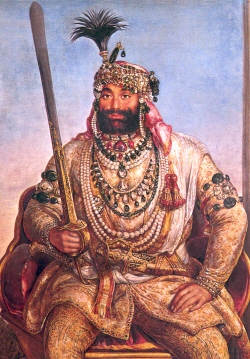Maharaja Ranjit Singh's throne


Maharaja Ranjit Singh's throne is an octagonal ceremonial throne crafted by the goldsmith Hafiz Muhammad Multani, likely between 1805 and 1810 in Lahore, for the eponymous ruler of the Sikh Empire, Ranjit Singh (r. 1801-1839) following the Sikh conquest of Multan in 1818. It is made of a wood and resin core, covered with sheets of repoussé, chased and engraved gold and is richly ornamented with floral and scroll motifs. It measures 94 cm in height, 90 cm in width, and 77 cm in depth, and weighs approximately 33 kg (excluding modern additions such as cushions). The current cushion fabric was added in the 1980s.[1]
Although Maharaja Ranjit Singh was attested to be personally modest in appearance, the sumptuous decor of his throne likely aimed to reflect the grandeur of his court. Unlike European royal furniture, which was often merely gilded, this throne was covered in solid sheet gold, underlining its visual of opulence. Its distinctive cusped base, composed of two tiers of lotus petals, references both Hindu iconography and Sikh symbolism, where the lotus signifies purity and divine authority.[1]
History
[edit]It shows the splendour of Ranjit Singh's court and is decorated with richly worked sheets of gold. The distinctive cusped base of this throne is composed of two tiers of lotus petals. The lotus is a symbol of purity and creation and a Lotus throne has traditionally been used as a seat or throne for Hindu gods. It is thought that as the Maharaja was renowned for the simplicity of his appearance and dislike of ceremony he rarely sat on this throne, preferring to sit cross-legged on carpets.
The throne was part of the empire's State Property seized from the Sikh treasury by the British East India Company in 1849 after their annexation of the Punjab in the Second Anglo-Sikh War. Many of those items were then auctioned in Lahore though the throne was taken to London and displayed with the other spoils of the British Empire at the Great Exhibition in 1851. It then went on be displayed in the East India Company's India Museum at Leadenhall Street.[2] An Indian student, Rakhal das Haldar wrote of visiting it there and recorded that "it was painful to see the state chair of gold of the late Lion of Punjab Ranjit Singh with a mere picture upon it".[2]
After the museum’s closure in 1879, it was transferred to the South Kensington Museum (now the Victoria & Albert Museum), where it is currently housed under inventory number 2518(IS). During the later half of the twentieth century, it was the subject of a repatriation by a Sikh regional organisation supported by the Indian government, but the claim was rejected by the museum.[2]
Bibliography
[edit]- Jackson, Anna, ed. (2001). V&A: A Hundred Highlights. V&A Publications.
References
[edit]- ^ a b Maharaja Ranjit Singh's throne Archived 2011-05-25 at the Wayback Machine V&A Museum.
- ^ a b c Vrdoljak, Ana Filipa. (2008). International law, museums and the return of cultural objects. Cambridge University Press. p. 69. ISBN 978-0-521-84142-9. OCLC 811317006. Archived from the original on 2020-06-10. Retrieved 2020-06-10.
